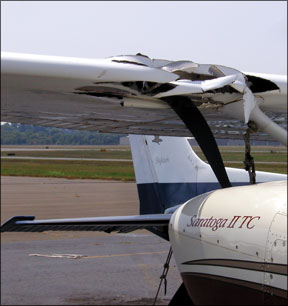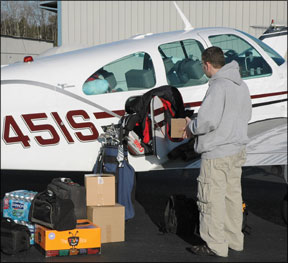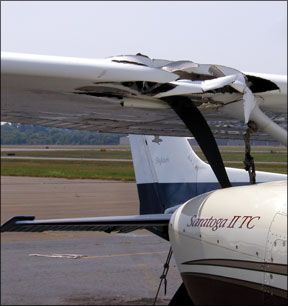If youre reading this article, chances are you are not the kind of pilot who would intentionally cut off someone off on final. You probably wouldnt attempt to verbally bully a nervous solo student into rushing her pre-takeoff checklist because your IFR clearance void time is ticking away. But what can you do if you find yourself wingtip to wingtip with such a self-absorbed and potentially dangerous individual? I thought about this after a recent flight with a pre-solo student, when the Very Important Pilot of a high-performance, single-engine Experimental aircraft-lets call him Pusher-nearly turned our productive hour of pattern work into an NTSB report. Hurry Up And Wait It was a sunny and unseasonably mild Saturday afternoon in February, and my student and I had stopped at Frederick Municipal Airport (FDK) in nearby Frederick, Md., for brunch after a morning of slow flight and stalls in the local practice area. 288 With our gas tanks and bellies full, we climbed back into the Cessna 172 with the intent of doing some touch-and-gos in the traffic pattern at FDK before heading home. While my student ran through the engine run-up checklist, Pusher rolled in behind us on the pad and was soon followed by half a dozen other aircraft of all shapes and sizes. Traffic jams are common at FDK on severe clear weekend days, but most of the time everyone manages to play together nicely. My student had just finished the last item on the checklist when Pusher keyed the mike and asked us if we were ready. I replied in the affirmative, and instructed my student to taxi up to the Runway 23 threshold. Before we could take off, though, we had to wait for the coast to be clear. A Skyhawk had just landed and was in the process of either doing a touch-and-go or slowing down to exit the runway. We werent sure which, but it was still occupying the pavement, which meant we stayed put. A second Skyhawk was on short final, and yet another aircraft was on base. My student asked me when he should go, and I told him to sit tight with his hand on the throttle until the first Skyhawk cleared the runway. Then, wed have to re-evaluate whether we had time to get airborne before the second Skyhawk was ready to land. “One-eight-six, would you mind getting into position and hold? There are six other aircraft behind you waiting to depart!” Pusher was trying to shove us onto the runway, but he chose to push the wrong person. Internally incensed but externally calm, I replied firmly, “Its my prerogative not to position and hold, so Im not going to. If you need to get out now you can use the intersection.” Perhaps I should have simply said, “Unable.” But I wanted my student to know that Pushers behavior was inappropriate and unacceptable. I wanted him to know that he should never let another pilot or even a controller coax him into doing something he is not comfortable with in an airplane. It was ramp rage, the airport version of road rage. Silence swept over the radio. We waited for the final traffic to land and exit the runway, and since the plane that was on base extended its pattern, we had enough space to depart safely. My student taxied onto the runway, made the radio call and took off. As we climbed through 700 feet AGL he asked me if it was time to turn crosswind, because he was still learning to make those decisions for himself. I told him to lift the left wing to check for traffic, and if the coast was clear, to make the turn. When he lifted the wing, he found Pusher climbing directly below and toward us, not more than a few wingspans away. If my student had turned crosswind without checking first, its likely none of us would have made it home for dinner that day. You dont have to be a pilot to see that Pusher let ramp rage drive him to commit a dangerous act in an airplane. Perhaps he felt insulted by my comment and wanted to give me his aerial version of “the bird” as he zoomed past us on the upwind. I will 288 never know what was going through his mind, but I do know what FAR 91.113 has to say on the subject: “Each aircraft that is being overtaken has the right-of-way and each pilot of an overtaking aircraft shall alter course to the right to pass well clear.” Which means that Pusher should have sidestepped to the right of our departure path in order to avoid a conflict. Better yet: If he thought he might outclimb us, he should have waited a bit longer before taking off behind us. But he chose not to, and that careless choice could have led to disaster. According to FAA data, FDK is the sixth busiest non-towered airport in the country and the busiest in the Washington, D.C. area, with more than 160,000 total operations each year. Close behind it at number nine in the nation is Carroll County Airport (DMW) in Westminster, Md., with more than 153,000 operations each year. These two airports are the places where I spend most of my time with students, because they are outside of the Washington, D.C. ADIZ and easily accessible from our practice area. My home airport, Montgomery County Airport (GAI) in Gaithersburg, Md., comes in at number 31 in the nation and the fourth busiest non-towered airport in the Washington area. See the chart on page 19; is your airport among the top 20? On Your Toes Can a control tower prevent ramp rage at Frederick, or even at the busiest non-towered facility in the nation, Flagler County Airport (X47) in Palm Coast, Fl.? Only time will tell, as FDK and X47 each have plans in the works to build control towers at their airports within the next few years. Nearly 75 percent of Flagler Countys 190,000 annual operations are related to flight training, mostly from nearby academies including Embry Riddles Daytona Beach campus. “Were an uncontrolled field but that doesnt mean were out of control,” said Flagler County Airport manager Jack Thompson. “I listen [to CTAF] all the time, and we get a whole lot of, Are you ready to go? Theres a lot more ribbing than there is malicious, or vicious talk.” I called FDK airport manager Charles M. Abell, Sr., to talk to him about my near miss on the upwind and find out whether hes observed bad behavior increasing at FDK, as the ADIZ has driven more local flight training activity their way. Abell said he gets few reports of ramp rage at FDK, but acknowledges that sometimes pilots are so focused on flying their airplanes that they dont listen or communicate properly on the radio. “You have to be on your toes,” advised Abell, who has been a pilot for 50 years. “Dont allow yourself to be complacent. Its something that a student and a teacher have to talk about ahead of time.” One of the conversations I have with my students very early on in their training deals with self-awareness and self-evaluation. I want them to always think about how they are feeling that day and whether anything going on in their lives could negatively affect their judgment and behavior in the cockpit. This ties in to the tried and true “IMSAFE” checklist, where the “S” stands for stress and the “F” stands for fatigue. Good pilots are supposed to be able to work effectively under pressure-to handle emergencies in a calm, rational manner, while continuing to fly the airplane safely to a landing-but this doesnt imply that its wise to fly after, say, getting fired from your job or finding out that your wife just left you for your best friend. Go for a run, pour a cold beer, meditate, hit a bucket of balls at the driving range-but dont fly an airplane. Those are the days when certain individuals are probably most likely to lean on the horn as the light turns green and rear-end a minivan full of children, or get impatient in the checkout line at the grocery store and start an argument with the cashier. That kind of behavior has no place at an airport, and can lead to disaster if it goes unchecked. R U SAFE? The FAA warns us of the Five Hazardous Attitudes that can lead to poor decision making and accidents (see sidebar on opposite page), and its important to understand that these can often manifest themselves in subtle ways and lead to ramp rage. As pilots, we need to be on the lookout for this behavior not only in ourselves but also in the pilots with whom we share the airport. Take impulsivity, for example. Lets say you are taxiing along toward your departure runway, and you notice another aircraft approaching the taxiway intersection from your left at a good clip. Youre not sure the aircraft is going to stop or even slow down at the intersection-at that rate, it might be airborne by then. You stop and wait and the aircraft turns onto the taxiway in front of you without saying a word on the CTAF, which he may not even be monitoring. You catch a glimpse of the solo pilot and notice that he has his head down, perhaps looking at a chart or tuning a radio. You mumble something unflattering about the pilot into the foam of your microphone, but hold your trigger finger still. At this point, you have a choice to make. Do you get on the radio and chastise the pilot for nearly bulldozing you over on the taxiway, or do you simply mind your own business and allow him to clear the area? It depends. If you think the pilot is behaving in an erratic or unsafe manner, perhaps the right thing to do is to try to communicate with the pilot in a non-threatening way. “Frederick Traffic, this is Skyhawk 12345 on the ground taxiing parallel to Runway 23. Twin Cessna that just entered the taxiway ahead of me, will you be an IFR or VFR departure?” Ive found that this is a polite way of asking another pilot if he or she will be holding for a clearance and possibly blocking my path to the runway, which puts the onus on me to either wait in line or find an alternate way out. In this case, it opens the door for the other pilot to respond so that I can sense his mood. If he responds in a professional manner, then perhaps I just snapped him out of a momentary lapse of attention, with no harm, no foul. But if he sounds agitated or upset with me for asking, then I might consider shoring up my defenses and getting out of his way. In retrospect I think that I may have incited Pusher to buzz me on departure, even though at the time I thought I was being exceedingly gracious considering how rude he was. A better course of action might have been to say, “Unable position and hold, but Id be happy to taxi back on the runway when clear to allow you to depart.” So the next time you are faced with ramp rage, try killing them with kindness. If it works in the grocery store checkout line, it can work on the runway. Meredith Saini is a freelance aviation writer and flight instructor flying from the Gaithersburg, Md., area.





